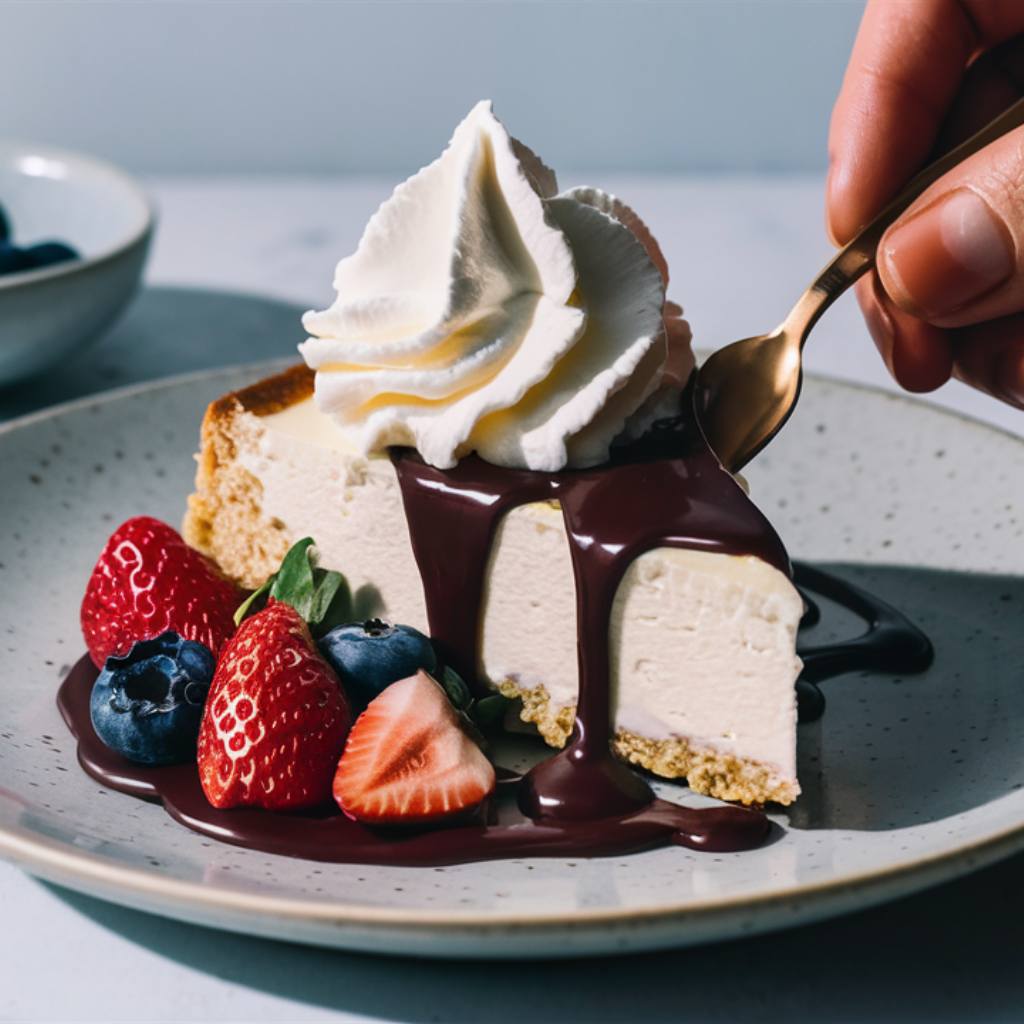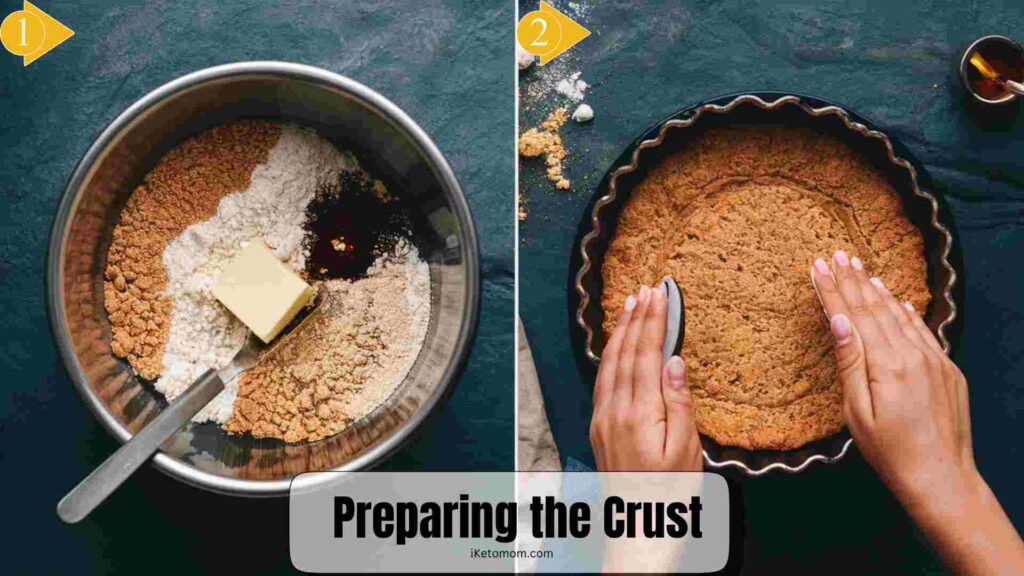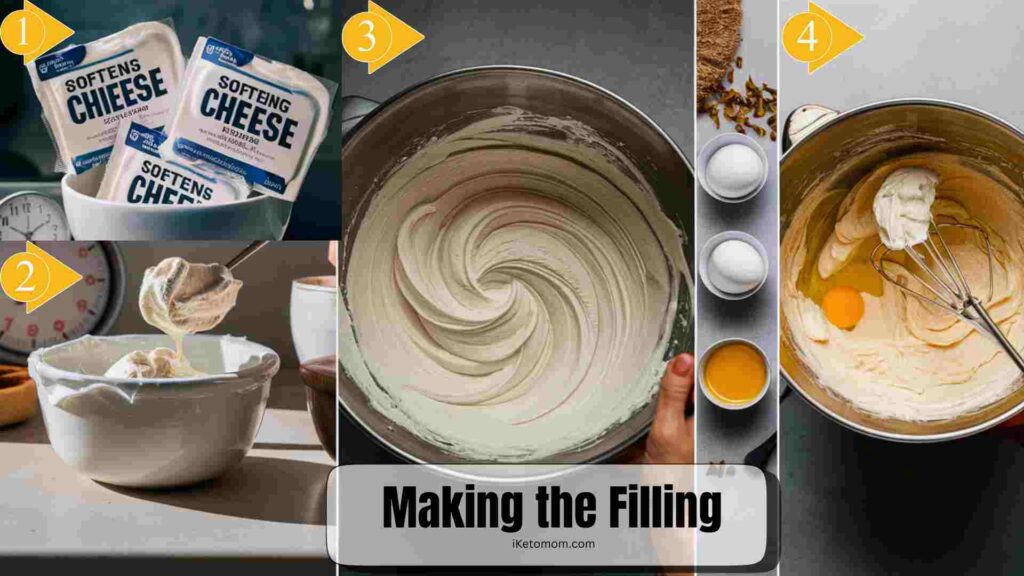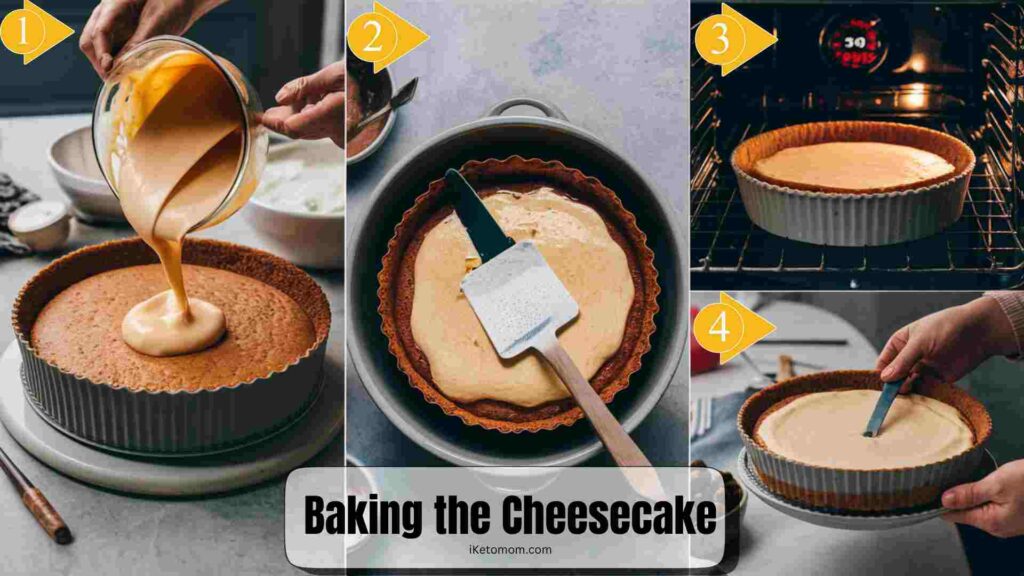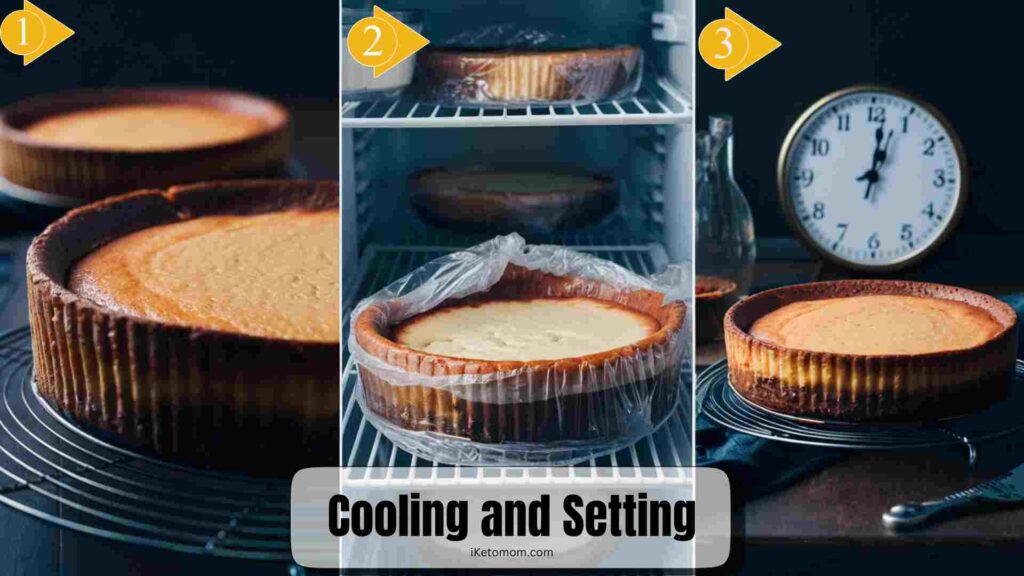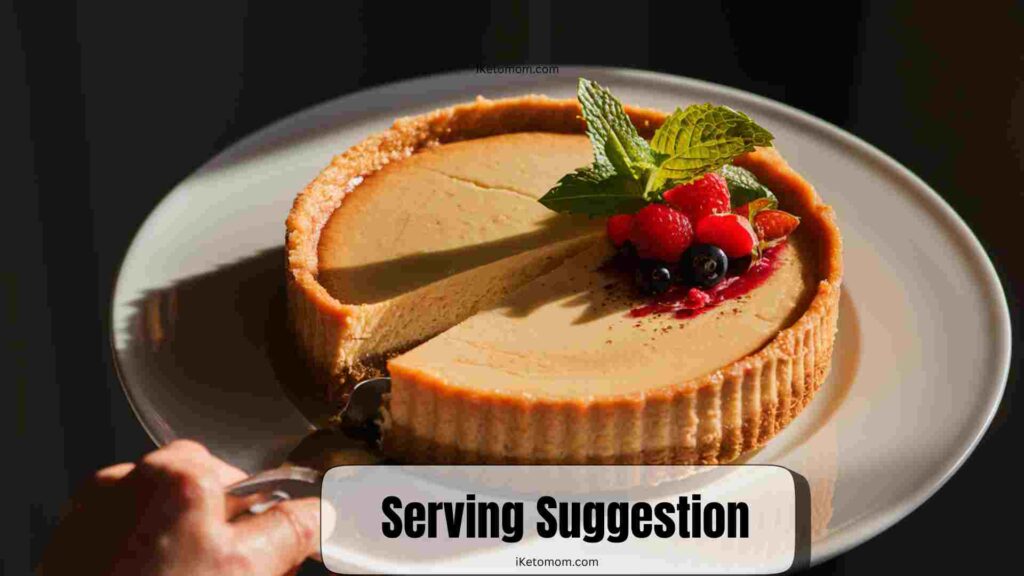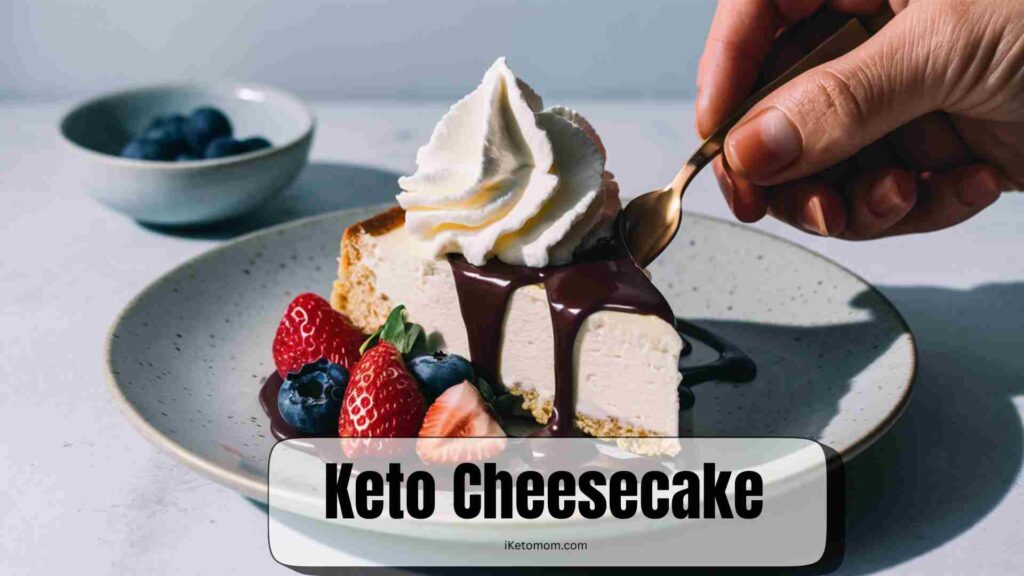Keto Cheesecake is a dessert specially crafted to align with the principles of the ketogenic diet. It replaces traditional high-carb ingredients like flour and sugar with low-carb alternatives such as almond flour and sugar substitutes like erythritol or stevia. This adaptation allows individuals following a keto lifestyle to indulge in a delicious treat without compromising their dietary goals.
Keto cheesecake holds significance for those on a keto diet for several reasons. Firstly, it provides a satisfying dessert option that mimics the taste and texture of traditional cheesecake while remaining low in carbohydrates. This is crucial for individuals aiming to maintain ketosis, as consuming too many carbs can disrupt this metabolic state. Additionally, keto cheesecake offers a way to curb cravings for sweet foods without derailing progress on the diet.
Keto Cheesecake Recipe
Ingredients
1. Cream Cheese
- Role: Provides the creamy and rich base for the cheesecake filling.
- Selection: Choose full-fat cream cheese for best texture and flavor.
- Softening: Allow the cream cheese to soften at room temperature for easier mixing and a smoother filling.
- Quantity: Typically, 24 ounces (3 packages) are used for a standard 9-inch cheesecake.
2. Keto Sweeteners
- Purpose: Adds sweetness without the carbs of regular sugar, keeping the cheesecake low-carb and ketogenic-friendly.
- Options: Erythritol, stevia, monk fruit, or a blend of these are commonly used keto sweeteners.
- Measurement: Use about 1 cup of keto sweetener, adjusting to taste preferences.
A toolkit of essential widgets and features that will supercharge your workflow
3. Almond or Coconut Flour (Crust)
- Base: Creates a low-carb crust that holds the cheesecake together.
- Texture: Almond flour provides a nutty flavor and a crumbly texture, while coconut flour offers a more dense and moist crust.
- Quantity: Typically, 1 ½ cups of almond or coconut flour are used for a standard crust.
4. Eggs and Heavy Cream
- Eggs: Add structure and stability to the cheesecake filling.
- Heavy Cream: Enhances creaminess and richness, ensuring a smooth texture.
- Quantity: Use 3 large eggs and about ½ cup of heavy cream for a standard cheesecake recipe.
5. Flavorings (Vanilla Extract, Lemon Juice)
- Vanilla Extract: Adds a sweet and aromatic flavor to the cheesecake.
- Lemon Juice: Optional but adds a slight tanginess that complements the richness of the cream cheese.
- Measurement: Use about 1 teaspoon of vanilla extract and 1 tablespoon of lemon juice for a balanced flavor profile.
These essential ingredients work together to create a delicious and keto-friendly cheesecake that’s low in carbs and high in flavor. Adjustments can be made based on personal preferences and dietary needs.
Instructions
1. Preparing the Crust
- Combining Ingredients:
- In a mixing bowl, combine 1 ½ cups of almond flour, ¼ cup of melted butter, ¼ cup of keto sweetener (like erythritol), and 1 teaspoon of vanilla extract.
- Mix until the ingredients form a crumbly dough-like texture.
- Pressing Mixture into the Pan:
- Grease a 9-inch springform pan and press the crust mixture evenly onto the bottom using your fingers or the back of a spoon.
- Ensure the crust is compact and covers the entire bottom of the pan.
- Baking or Chilling the Crust:
- For a baked crust, preheat the oven to 350°F (175°C) and bake the crust for about 10-12 minutes until lightly golden.
- Alternatively, you can chill the crust in the refrigerator for 30-60 minutes to set.
2. Making the Filling
- Softening Cream Cheese:
- Allow 24 ounces (3 packages) of cream cheese to soften at room temperature for about 30 minutes. This makes it easier to mix and creates a smoother filling.
- Adding Sweetener and Mixing Until Smooth:
- In a large mixing bowl, beat the softened cream cheese until smooth and creamy.
- Add 1 cup of keto sweetener gradually while continuing to beat until well combined and smooth.
- Incorporating Eggs One at a Time:
- Add 3 large eggs to the cream cheese mixture one at a time, beating well after each addition.
- Make sure each egg is fully incorporated before adding the next.
- Adding Heavy Cream and Vanilla Extract:
- Pour in ½ cup of heavy cream and 1 teaspoon of vanilla extract into the bowl.
- Beat the mixture until everything is thoroughly combined and the filling is smooth and creamy.
3. Baking the Cheesecake
- Pouring Filling Over Crust:
- Pour the prepared cheesecake filling over the cooled crust in the springform pan.
- Use a spatula to smooth out the top and ensure an even layer.
- Pre-Baking Preparation (Water Bath Method):
- Place the filled springform pan inside a larger baking dish or roasting pan.
- Fill the larger pan with hot water to create a water bath. This helps prevent the cheesecake from cracking during baking.
- Baking Time and Temperature:
- Bake the cheesecake in the preheated oven at 325°F (160°C) for about 50-60 minutes.
- The cheesecake is done when the edges are set, but the center still has a slight jiggle.
- Checking for Doneness:
- To check if the cheesecake is done, gently shake the pan. The center should move slightly like Jell-O but not be liquidy.
4. Cooling and Setting
- Cooling at Room Temperature:
- Remove the cheesecake from the oven and let it cool in the springform pan at room temperature for about 1 hour.
- This helps the cheesecake to set and firm up slightly.
- Refrigerating for Several Hours or Overnight:
- Once cooled, cover the cheesecake with plastic wrap or foil and refrigerate it for at least 4-6 hours, preferably overnight.
- Chilling allows the flavors to develop fully and gives the cheesecake time to set completely.
5. Serving Suggestion
- For a delightful serving suggestion, pair slices of Keto Cheesecake with a dollop of sugar-free whipped cream and a garnish of fresh berries. Alternatively, drizzle a sugar-free chocolate ganache over each slice for an indulgent treat.
Also, Try: Yummy Keto Strawberry Cheesecake, Keto Lemon Cheesecake, Keto Cheesecake Fluff, No Bake Keto Cheesecake, Keto Cheesecake Bites
These instructions provide a detailed and structured approach to creating a delicious Keto Cheesecake. Starting with the crust, the process involves combining almond flour, melted butter, keto sweetener, and vanilla extract to form a crumbly yet cohesive mixture that is pressed into the pan and either baked for a golden finish or chilled for a firm base.
Keto Cheesecake is a delectable dessert designed specifically for those following a ketogenic diet. It embodies the rich, creamy texture and indulgent flavor of traditional cheesecake while adhering to the low-carbohydrate, high-fat principles of the keto lifestyle.
This dessert replaces traditional high-carb ingredients like wheat flour and sugar with keto-friendly alternatives. Almond or coconut flour is often used for the crust, providing a nutty and satisfying base. Keto-approved sweeteners such as erythritol, stevia, or monk fruit extract replace sugar, ensuring sweetness without the spike in blood sugar levels.
Keto Cheesecake Nutrition Info
Here’s a nutrition table for a typical slice of Keto Cheesecake (assuming 12 servings):
| Nutrient | Amount per Serving |
|---|---|
| Calories | 350 |
| Total Fat | 32g |
| – Saturated Fat | 18g |
| Cholesterol | 130mg |
| Sodium | 250mg |
| Total Carbohydrates | 5g |
| – Dietary Fiber | 1g |
| – Sugars | 2g |
| Protein | 9g |
Please note that these values are approximate and can vary based on the specific ingredients and brands used in your recipe. Adjustments may be needed based on the actual nutritional content of your Keto Cheesecake.
Here’s a consolidated nutrition table for each ingredient used in Keto Cheesecake:
| Ingredient | Serving Size | Calories | Total Fat | Saturated Fat | Cholesterol | Sodium | Total Carbohydrates | Dietary Fiber | Sugars | Protein |
|---|---|---|---|---|---|---|---|---|---|---|
| Cream Cheese | 1 oz | 100 | 10g | 6g | 30mg | 100mg | 1g | 0g | 1g | 2g |
| Almond Flour | 1/4 cup | 180 | 16g | 1g | 0mg | 0mg | 6g | 3g | 1g | 6g |
| Eggs | 1 large egg | 70 | 5g | 1.5g | 185mg | 70mg | 0.5g | 0g | 0g | 6g |
| Heavy Cream | 1 oz | 100 | 10g | 6g | 35mg | 10mg | 1g | 0g | 0g | 1g |
| Keto Sweeteners | 1 teaspoon | Varies* | Varies* | Varies* | Varies* | Varies* | Varies* | Varies* | Varies* | 0g |
Values for keto sweeteners can vary significantly based on the specific type and brand used. Common options like erythritol, stevia, or monk fruit extract are typically zero-calorie and have negligible effects on blood sugar. Always check the nutrition labels on your ingredients for the most accurate information.
Tips for Best Results 🍽
Here are some tips to ensure the best results when making Keto Cheesecake:
- Room Temperature Ingredients: Allow cream cheese, eggs, and heavy cream to come to room temperature before using. This ensures a smooth and evenly mixed filling.
- Softened Cream Cheese: Soften cream cheese properly to avoid lumps in the filling. Leave it out at room temperature for about 30 minutes or use the microwave at low power in short intervals.
- Mixing Technique: Use an electric mixer on medium speed to beat the cream cheese and sweetener until creamy and smooth. Avoid over-mixing to prevent incorporating too much air into the filling.
- Gradual Egg Incorporation: Add eggs one at a time, mixing well after each addition. This helps to evenly distribute the eggs in the filling and prevents any eggy taste.
- Water Bath Method: Consider using a water bath (placing the springform pan in a larger pan with hot water) while baking. This helps regulate the temperature and prevents cracking on the surface of the cheesecake.
- Prevent Cracks: To further prevent cracking, avoid over-baking the cheesecake. The center should still have a slight jiggle when gently shaken.
- Cooling Process: Cool the cheesecake at room temperature for about an hour before transferring it to the refrigerator. This gradual cooling process helps prevent cracks and ensures a smooth texture.
- Refrigeration Time: Refrigerate the cheesecake for several hours or preferably overnight before serving. This allows the flavors to meld together and the cheesecake to set properly.
- Serve Chilled: For the best taste and texture, serve the cheesecake chilled. Let it sit at room temperature for a few minutes before slicing to slightly soften the filling.
- Variations and Toppings: Get creative with flavor variations and toppings. Add cocoa powder for a chocolate version or swirl in berry puree for a fruity twist. Sugar-free toppings like fresh berries or whipped cream make excellent low-carb additions.
Following these tips will help you achieve a perfectly creamy, smooth, and delicious Keto Cheesecake every time!
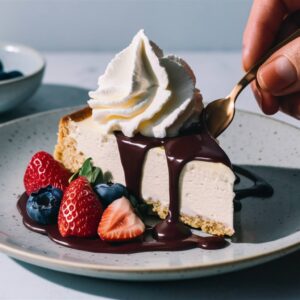
Keto Cheesecake Recipe
Equipment
- Springform Pan Essential for easy removal of the cheesecake without damaging it.
- Mixing bowls For combining crust and filling ingredients.
- Electric Mixer To thoroughly blend the cream cheese and other filling ingredients until smooth.
- Measuring cups and spoons For accurately measuring ingredients.
- Spatula For scraping down the sides of the bowl and ensuring all ingredients are well mixed.
- Oven For baking the crust and the cheesecake.
- Baking sheet To place under the springform pan for stability and to catch any drips.
- Aluminum Foil To wrap around the springform pan if using a water bath, preventing water from seeping in.
- Roasting Pan If using a water bath method, to hold the springform pan and water.
- Cooling Rack For cooling the cheesecake at room temperature before refrigerating.
- Knife For slicing and serving the cheesecake.
Ingredients
For the Crust:
- 1 ½ Cups Almond Flour
- ¼ Cup Melted butter
- ¼ Cup Granulated erythritol or your preferred keto sweetener
- 1 Teaspoon Vanilla Extract
For the Filling:
- 24 Ounces (3 packages) cream cheese, softened
- 1 Cup Granulated Erythritol or your preferred keto sweetener
- 3 Large Eggs
- 1 Teaspoon Vanilla Extract
- ½ Cup Heavy Cream
- 1 Teaspoon Lemon juice (optional, for a slight tang)
Optional Toppings:
- Fresh berries (strawberries, blueberries, raspberries)
- Sugar-free chocolate ganache
- Whipped cream (sugar-free)
Instructions
- Preparing the Crust
- Combine almond flour, melted butter, sweetener, and vanilla extract.
- Press the mixture into the bottom of a greased springform pan.
- Bake the crust until lightly golden or chill it in the refrigerator.
- Making the Filling
- Soften cream cheese until smooth.
- Mix in sweetener until well combined.
- Add eggs one at a time, mixing after each addition.
- Incorporate heavy cream and vanilla extract into the filling mixture.
- Baking the Cheesecake
- Pour the filling over the prepared crust.
- Prepare a water bath by placing the springform pan in a larger pan with hot water.
- Bake at a specified temperature for a set amount of time.
- Check for doneness by gently shaking the pan to see if the center is set.
- Cooling and Setting
- Cool the cheesecake at room temperature for a while.
- Refrigerate the cheesecake for several hours or overnight to allow it to set completely before serving.
Notes
Delicious Topping Ideas
Here are some delicious topping ideas to enhance your Keto Cheesecake:
1. Fresh Berries:
Top the cheesecake with a mix of fresh berries such as strawberries, blueberries, and raspberries. Berries are low in carbs and add a burst of natural sweetness and vibrant colors.
2. Sugar-Free Fruit Compote:
Make a sugar-free fruit compote using berries or other keto-friendly fruits like rhubarb or peaches. Simmer the fruits with a keto sweetener until they soften and release their juices, then spoon the compote over the cheesecake.
3. Sugar-Free Chocolate Ganache:
Drizzle the cheesecake with a rich and decadent sugar-free chocolate ganache. Simply melt sugar-free chocolate chips with heavy cream until smooth and pourable, then pour it over the chilled cheesecake.
4. Whipped Cream:
Top the cheesecake with a generous dollop of homemade sugar-free whipped cream. Add a touch of vanilla extract or a sprinkle of cocoa powder for extra flavor.
5. Nut Butter Swirl:
Swirl a spoonful of sugar-free nut butter (such as almond or peanut butter) into the top of the cheesecake before chilling. It adds a creamy texture and nutty flavor.
6. Toasted Coconut Flakes:
Sprinkle toasted unsweetened coconut flakes over the cheesecake for a tropical twist. Toast the coconut in a dry skillet until golden brown before adding it to the cheesecake.
7. Caramel Sauce:
Drizzle the cheesecake with a sugar-free caramel sauce made with keto-friendly sweeteners. It adds a rich and indulgent caramel flavor without the extra carbs.
8. Lemon Curd:
Top the cheesecake with a spoonful of tangy sugar-free lemon curd for a refreshing and citrusy contrast to the creamy filling.
9. Chopped Nuts:
Sprinkle chopped nuts like pecans, walnuts, or almonds over the top of the cheesecake for added crunch and nuttiness.
10. Herb Infusion:
For a unique twist, infuse the topping with herbs like fresh mint or basil. Chop the herbs finely and sprinkle them over the cheesecake for a refreshing and aromatic touch.
These topping ideas not only add flavor and visual appeal to your Keto Cheesecake but also keep it low-carb and keto-friendly. Feel free to mix and match toppings to create your own delicious combinations!
FAQ
Is cheesecake ok to eat on a keto diet?
Yes, cheesecake can be okay to eat on a keto diet, provided it’s made with keto-friendly ingredients. Traditional cheesecakes are typically high in sugar and carbs due to ingredients like flour and sugar in the crust and filling. However, keto cheesecake recipes replace these high-carb ingredients with low-carb alternatives.
Here’s how cheesecake can fit into a keto diet:
- Low-Carb Crust: Keto cheesecakes use almond flour or coconut flour instead of wheat flour for the crust, significantly reducing the carb content. Additionally, keto sweeteners like erythritol, stevia, or monk fruit extract replace sugar in the crust, ensuring it remains low in carbs.
- High-Fat Filling: The filling of keto cheesecake consists of cream cheese, eggs, heavy cream, and keto-friendly sweeteners. Cream cheese and heavy cream are high in fat and low in carbs, making them suitable for a ketogenic diet.
- Keto Sweeteners: Keto cheesecakes use sugar substitutes like erythritol, stevia, or monk fruit extract to sweeten the filling without spiking blood sugar levels. These sweeteners have minimal impact on insulin and blood glucose, making them ideal for keto diets.
- Moderate Consumption: While keto cheesecake can be a delicious treat on a ketogenic diet, it’s essential to consume it in moderation. Although it’s lower in carbs compared to traditional cheesecake, it still contains calories and fats, so portion control is key.
By following a keto-friendly cheesecake recipe and being mindful of portion sizes, you can enjoy this decadent dessert without straying from your keto goals.
Is Keto Cheesecake suitable for a ketogenic diet?
Yes, Keto Cheesecake is indeed suitable for a ketogenic diet when prepared using keto-friendly ingredients. The key to making a keto cheesecake is to replace high-carb ingredients with low-carb alternatives while ensuring a high-fat content. Here’s how Keto Cheesecake fits into a ketogenic diet:
- Low-Carb Crust: Traditional cheesecake crusts often use wheat flour and sugar, which are high in carbs. In a keto cheesecake, almond flour or coconut flour can be used instead, significantly reducing the carb content. Keto-approved sweeteners like erythritol, stevia, or monk fruit extract replace sugar in the crust.
- High-Fat Filling: The filling of a keto cheesecake typically includes cream cheese, eggs, and heavy cream. These ingredients are high in fat and low in carbs, making them perfect for a ketogenic diet. Keto-friendly sweeteners are used to sweeten the filling without adding extra carbs.
- Ketosis Maintenance: By using low-carb and high-fat ingredients, Keto Cheesecake helps maintain ketosis, the metabolic state where the body burns fat for fuel instead of carbs. This is a key aspect of the ketogenic diet.
- Portion Control: While Keto Cheesecake is suitable for a ketogenic diet, it’s essential to practice portion control. Even though it’s lower in carbs compared to traditional cheesecake, it still contains calories and fats. Enjoying it in moderation ensures it aligns with your dietary goals.
Overall, Keto Cheesecake can be a delicious and satisfying dessert option for those following a ketogenic diet, as long as it’s made with keto-friendly ingredients and consumed in appropriate portions.
Can I use regular sugar in Keto Cheesecake?
It’s not recommended to use regular sugar in Keto Cheesecake if you want to keep it low-carb and suitable for a ketogenic diet. Regular sugar is high in carbohydrates, which can significantly impact blood sugar levels and hinder the state of ketosis.
Instead of regular sugar, consider using keto-friendly sweeteners such as:
- Erythritol: A sugar alcohol with zero calories and a low glycemic index, making it an excellent choice for keto desserts.
- Stevia: A natural sweetener derived from the stevia plant, known for its zero-calorie and low-carb properties.
- Monk Fruit Extract: Another natural sweetener with zero calories and a low glycemic index, making it suitable for keto baking.
- Allulose: A rare sugar that tastes like sugar but has minimal impact on blood glucose levels, making it keto-friendly.
These keto sweeteners can be used in place of regular sugar in the crust and filling of Keto Cheesecake to achieve the desired level of sweetness without compromising your ketogenic goals. They provide sweetness without the carbs, helping you stay in ketosis while enjoying a delicious dessert.
How can I prevent my Keto Cheesecake from cracking?
Preventing your Keto Cheesecake from cracking requires careful preparation and baking techniques. Here are some tips to help you avoid cracks:
- Use Room Temperature Ingredients: Ensure that all ingredients, especially the cream cheese and eggs, are at room temperature before mixing. This helps create a smooth and evenly blended filling, reducing the risk of cracks.
- Avoid Over-Mixing: Mix the cheesecake filling just until smooth and creamy. Over-mixing can incorporate too much air into the batter, leading to cracks during baking.
- Water Bath Method: Consider using a water bath when baking your cheesecake. Place the springform pan containing the cheesecake into a larger pan filled with hot water before placing it in the oven. The water bath helps regulate the temperature and prevents the cheesecake from drying out and cracking.
- Gradual Cooling: After baking, allow the cheesecake to cool gradually. Turn off the oven and let the cheesecake sit inside with the door slightly ajar for about an hour before removing it. This gradual cooling helps prevent sudden temperature changes that can cause cracks.
- Don’t Over-Bake: Avoid over-baking the cheesecake. It should be slightly jiggly in the center when gently shaken. The residual heat will continue to cook the cheesecake as it cools, so remove it from the oven when it’s almost set but still has a slight wobble.
- Use a Springform Pan: Bake your cheesecake in a springform pan with a removable bottom. This makes it easier to remove the cheesecake from the pan without damaging its delicate structure.
By following these tips and techniques, you can significantly reduce the chances of your Keto Cheesecake developing cracks and achieve a smooth, creamy, and visually appealing dessert.
How long does Keto Cheesecake last in the refrigerator?
Keto Cheesecake can typically last in the refrigerator for about 4 to 5 days if stored properly. Here are some guidelines to help you maximize the shelf life of your cheesecake:
- Storage Container: Store the cheesecake in an airtight container or cover it tightly with plastic wrap or aluminum foil. This helps prevent it from drying out and absorbing odors from other foods in the refrigerator.
- Cooling Time: Allow the cheesecake to cool completely at room temperature before refrigerating it. This helps maintain its texture and prevents condensation from forming on the surface.
- Avoid Moisture: Keep the cheesecake away from moisture sources in the refrigerator, such as uncovered food items or vegetable drawers. Excess moisture can cause the cheesecake to become soggy.
- Separate Toppings: If your cheesecake has toppings like whipped cream, fruit compote, or chocolate ganache, consider adding them just before serving rather than storing them on the cheesecake. This helps maintain the freshness and texture of the toppings.
- Labeling: If you’re storing the cheesecake for more than a day, it’s helpful to label the container with the date of preparation. This way, you can keep track of its freshness and consumption timeline.
- Best Consumed Fresh: While Keto Cheesecake can last several days in the refrigerator, it’s best consumed within the first few days for optimal taste and texture. As time passes, the cheesecake may start to lose its freshness and creaminess.
By following these storage tips, you can enjoy your Keto Cheesecake for several days while maintaining its quality and deliciousness. If you plan to store it for longer periods, consider freezing individual portions for extended freshness.

I’m Priscilla Swahn, a registered dietitian with a master’s degree in nutritional sciences. With over a decade of experience in holistic nutrition, I specialize in creating delicious keto recipes to help you enjoy a healthy lifestyle. On iKetoMom, you’ll find a variety of recipes for every meal—hearty breakfasts, satisfying lunches, mouthwatering dinners, indulgent desserts, and refreshing drinks. My recipes make keto living easy and enjoyable for the whole family. Featured in EatingWell and MindBodyGreen, I also collaborate with health centers and corporate companies to share my expertise. Join me and discover the joy of keto cooking!

